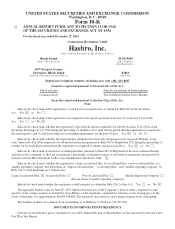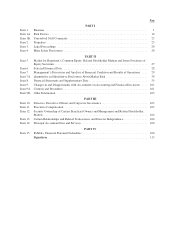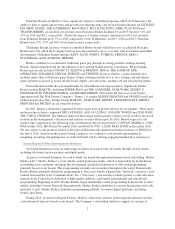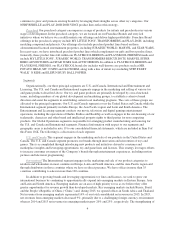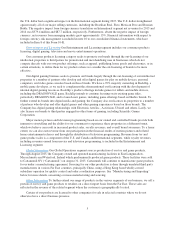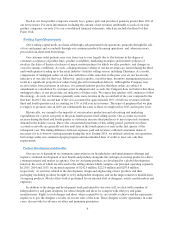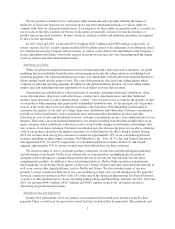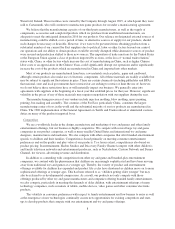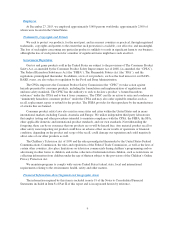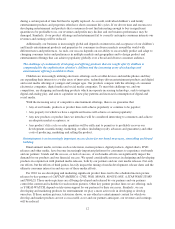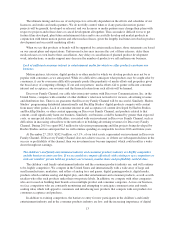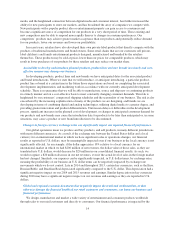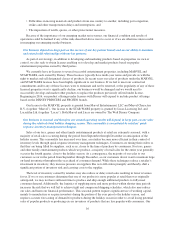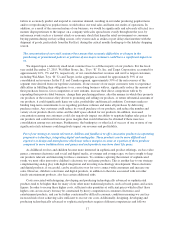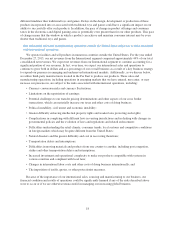Hasbro 2015 Annual Report Download - page 19
Download and view the complete annual report
Please find page 19 of the 2015 Hasbro annual report below. You can navigate through the pages in the report by either clicking on the pages listed below, or by using the keyword search tool below to find specific information within the annual report.
Waterford, Ireland. These facilities were owned by the Company through August 2015, at which point they were
sold to Cartamundi, who will continue to manufacture game products for us under a manufacturing agreement.
We believe that the manufacturing capacity of our third party manufacturers, as well as the supply of
components, accessories and completed products which we purchase from unaffiliated manufacturers, are
adequate to meet the anticipated demand in 2016 for our products. Our reliance on designated external sources of
manufacturing could be shifted, over a period of time, to alternative sources of supply for our products, should
such changes be necessary or desirable. However, if we were to be prevented from obtaining products from a
substantial number of our current Far East suppliers due to political, labor or other factors beyond our control,
our operations and our ability to obtain products would be severely disrupted while alternative sources of product
were secured and production shifted to those new sources. The imposition of trade sanctions by the United States
or the European Union against a class of products imported by us from, or the loss of “normal trade relations”
status with, China, or other factors which increase the cost of manufacturing in China, such as higher Chinese
labor costs or an appreciation in the Chinese Yuan, could significantly disrupt our operations and/or significantly
increase the cost of the products which are manufactured in China and imported into other markets.
Most of our products are manufactured from basic raw materials such as plastic, paper and cardboard,
although certain products also make use of electronic components. All of these materials are readily available but
may be subject to significant fluctuations in price. There are certain chemicals (including phthalates and BPA)
that national, state and local governments have restricted or are seeking to restrict or limit the use of; however,
we do not believe these restrictions have or will materially impact our business. We generally enter into
agreements with suppliers at the beginning of a fiscal year that establish prices for that year. However, significant
volatility in the prices of any of these materials may require renegotiation with our suppliers during the year.
The manufacturing processes of our vendors include injection molding, blow molding, spray painting,
printing, box making and assembly. The countries of the Far East, particularly China, constitute the largest
manufacturing center of toys in the world and the substantial majority of our toy products are manufactured in
China. The 1996 implementation of the General Agreement on Tariffs and Trade reduced or eliminated customs
duties on many of the products imported by us.
Competition
We are a worldwide leader in the design, manufacture and marketing of toys and games and other family
entertainment offerings, but our business is highly competitive. We compete with several large toy and game
companies in our product categories, as well as many smaller United States and international toy and game
designers, manufacturers and marketers. We also compete with other companies that offer branded entertainment
specific to children and their families. Competition is based primarily on meeting consumer entertainment
preferences and on the quality and play value of our products. To a lesser extent, competition is also based on
product pricing. In entertainment, Hasbro Studios and Discovery Family Channel compete with other children’s
and family television networks and entertainment producers, such as Nickelodeon, Cartoon Network and Disney
Channel, for viewers, advertising revenue and distribution.
In addition to contending with competition from other toy and game and branded-play entertainment
companies, we contend with the phenomenon that children are increasingly sophisticated and have been moving
away from traditional toys and games at a younger age. Thereby, the variety of product and entertainment
offerings available for children has expanded and product life cycles have shortened as children move on to more
sophisticated offerings at younger ages. This has been referred to as “children getting older younger” but may
also be referred to as developmental compression. As a result, our products not only compete with those
offerings produced by other toy and game manufacturers and companies offering branded family entertainment,
we also compete, particularly in meeting the demands of older children, with entertainment offerings of many
technology companies, such as makers of tablets, mobile devices, video games and other consumer electronic
products.
The volatility in consumer preferences with respect to family entertainment and low barriers to entry as well
as the emergence of new technologies continually creates new opportunities for existing competitors and start-
ups to develop products that compete with our entertainment and toy and game offerings.
8



